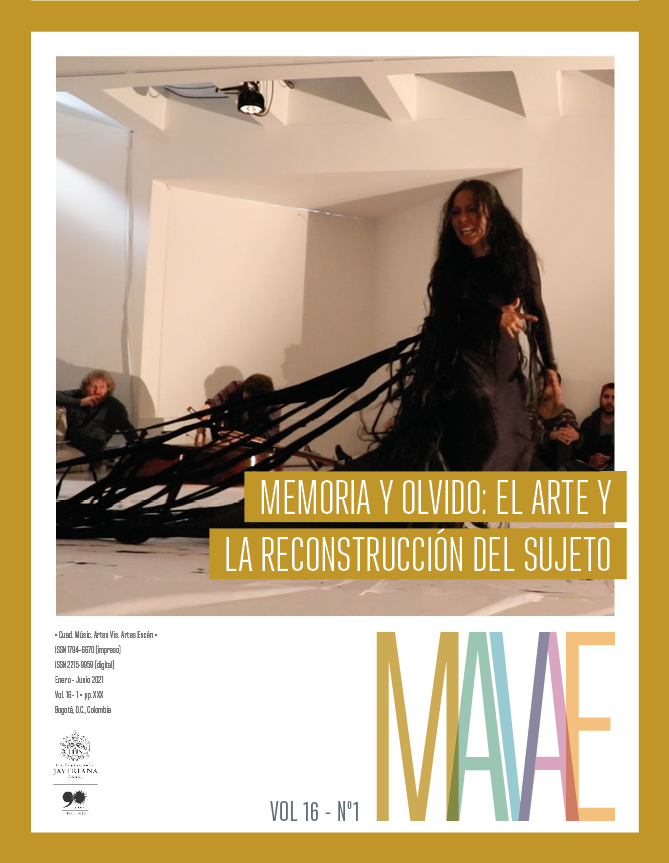Abstract
The movie Closet Monster, written and directed by Stephen Dunn and considered one of the top ten Canadian movies of 2015 by the Toronto International Film Festival (TIFF), is heavily influenced by queer cinema and uses music as a fundamental element to characterize the protagonist, follow the plot, and give a meaning to the film that would not be the same without it. This paper focuses on a scene near the end of the movie (71’32”-75’43”) that uses the post-minimalist music piece, Trance 4 (1995), by American composer Michael Gordon and performed by the band Icebreaker. Based on the short, this paper offers an analysis that aims to highlight the track’s contribution to the composition of the scene and to discuss the mutual influence of musical and visual languages, both located in trends with certain characteristics — namely queer cinema and post-minimalism, respectively. To that end, the analysis shifts between concepts such as musivisual language, synchronization points, and musical post-minimalism. The paper opens with some thoughts about post-minimalist music, queer cinema, and the protagonists of Trance, by way of contextualization, followed by an exploration of the Closet Monster scene, set to the track “Trance 4.” To conclude, the paper emphasizes the role of music in the composition of the scene. With this paper, we seek to contribute to broadening the debate on the use of post-minimalist music in queer cinema.
“Bang on a Can”. Acesso 03 de dezembro de 2019, https://bangonacan.org/ store/music/trance.
"Cantaloupe Music”. Acesso 03 de dezembro de 2019, https://cantaloupemusic.com/artists/michael-gordon.
“Icebreaker”. Acesso 10 de dezembro de 2019. http://www.icebreaker.org.uk/repertoire/
“Michael Gordon” Acesso 03 de dezembro de 2019 https://michaelgordonmusic.com/about/bio.
Butler, Judith. 2003. Problemas de gênero: feminismo e subversão da identidade. Rio de Janeiro: Civilização Brasileira.
Chion, Michel. 2008. A audiovisão: som e imagem no cinema. Lisboa:Edições Texto e Grafia.
Cohen, Annabel. 1999. “Functions of music in multimedia: a cognitive approach”. Em Music, mind, and science, 40–68. Seoul, Korea: Seoul National University Press.
— 2001. “Music as a source of emotion in film”. Em Music and emotion: Theory and research, editado por Patrik N. Juslin, John A. Sloboda, 249–72. Reino Unido: Oxford University Press. https://t.ly/V2Gb
Duncan, Carol. 2012. “Quem rege o mundo da arte?” Em Intermidialidade e estudos interartes: desafios da arte contemporânea 2, editado por Thaïs Flores Nogueira Diniz e André Soares Vieira, 17–39. Belo Horizonte: Rona Editora. https://t.ly/znUy
Dunn, Stephen, dir. 2015. Closet Monster. Canadá: Rhombus Media / Best Boy Entertainment.
Eisenstein, Serguei. 2002a. A forma do filme. Rio de Janeiro: Jorge Zahar Ed.
— 2002b. O sentido do filme. Rio de Janeiro: Jorge Zahar Ed.
Gann, Kyle. 2001. “Minimal music, maximal impact: Minimalism defined”.
New Music USA. 1 de novembro, 2001. https://nmbx.newmusicusa.org/minimal-music-maximal-impact/2/
Gértrudix, Manuel. 2003. Música, narración y medios audiovisuales. Madrid: Ediciones del Laberinto. https://t.ly/t397
Glazer, Joshua. 2017. “Orgullo Dance: el origen gay de la música electrónica”. VICE. 6 de junho de 2017. https://t.ly/C7EP
Kozinn, Allan. 2004. “MUSIC; The New York Composer Better Known Abroad” The New York Times, 9 de maio, 2004. https://t.ly/URb1
León, José. 2016. “Tortuoso camino a la autoaceptación”. Revista EL Antepenúltimo Mohicano. https://t.ly/5JHu. Acesso 10 de dezembro de 2019.
Leydon, Rebecca. 2002. “Towards a Typology of Minimalist Tropes”. Music Theory Online 4, 8. http://www.mtosmt.org/issues/mto.02.8.4/mto.02.8.4.leydon.html. Acesso 27 de novembro de 2019.
Lynch, Dave. 2005. “Michael Gordon / Icebreaker: Trance [2005]”. Resenha de Trance, de Michael Gordon. All music. https://t.ly/48qd
Macaulay, Scott. 2016. “Five Questions for Closet Monster Writer/Director Stephen Dunn”. Filmmaker Magazine: Directors Interviews, 23 de setembro de 2016. https://t.ly/Dbeg
Masnikosa, Marija. 2013. “A Theoretical Model of Postminimalism and Two Brief ‘Case Studies’”. Em The Ashgate Research Companion to Minimalist and Postminimalist Music. 297–313. England: Ashgate Publishing Limited.
Mennel, Barbara. 2012. Queer cinema: Schoolgirls, vampires and gay cowboys. Nova York: Columbia University Press.
Novak, Jelena. 2013. “From minimalist music to postopera: repetition, representation and (post) modernity in the operas of Philip Glass and Louis Andriessen”. Em The Ashgate Research Companion to Minimalist and Postminimalist Music. England: Ashgate Publishing Limited.
Petković, Danijela. 2018. “Heteronormativity and Toxic Masculinity in Stephen Dunn’s Closet Monster”. AM Journal of Art and Media Studies, 16: 43–54. http://dx.doi.org/10.25038/am.v0i16.253
Potter, Keith. 1996. “Classical music: Icebreaker; Queen Elizabeth Hall, sbc, London”. The Independent. 04 de dezembro de 1996. https://t.ly/optE
Potter, Keith, Kyle Gann e Pwyll Siôn. 2013. The Ashgate Research Companion to Minimalist and Postminimalist Music. England: Ashgate Publishing Limited.
Rajewsky, Irina. 2012 “A fronteira em discussão: o status problemático das fronteiras midiáticas no debate contemporâneo sobre intermidialidade”. Em Intermidialidade e estudos interartes: desafios da arte contemporânea 2. 51–73. Belo Horizonte: Rona Editora. https://t.ly/znUy
Robin, William. 2017. “Bang on a Can and Minimalism.” Sexta Conferência Internacional de Música e Minimalismo, University
of Tennessee, Knoxville, 21 a 25 de junho.
Rocha, Cássio Bruno Araújo. 2014. Um pequeno guia ao pensamento, aos conceitos e à obra de Judith Butler. Resenha de Judith Butler e a teoria queer, de Sara Salih. Cadernos Pagu, 43 jul./dez. 507– 516. http://dx.doi.org/10.1590/0104-8333201400430507
Román, Alejandro. 2008. El lenguaje musivisual: semiótica y estética de la música cinematográfica. Madrid: Visión Libros.
Santos, Rita de Cássia Domingues. 2019. Repensando a terceira fasecomposicional de Gilberto Mendes: o Pós-Minimalismo nos mares do sul. Curitiba: CRV.
Scarpetta, Guy. 1985. L’Impureté. Paris: Editions Grasset & Fasquelle.
Schafer, Murray. 2011. O ouvido pensante. Trad. Marisa Trench O.
Fonterrada, Magda R. Gomes da Silva e Maria Lúcia Pascoal. 2.ed. São Paulo: Unesp.
Schwarz, K. Robert. 1996. Minimalists. Londres: Phaidon Press.
Strauss, Anselm. 1999. Espelhos e máscaras: A busca de identidade.
São Paulo: Editora da Universidade de São Paulo.
Strickland, Edward. 2000. Minimalism: Origins. Bloomington: Indiana University Press.

This work is licensed under a Creative Commons Attribution 4.0 International License.
Copyright (c) 2021 Nadia Imelda Moncada Sevilla, Maristela Carneiro, Rita de Cássia Domingues dos Santos



